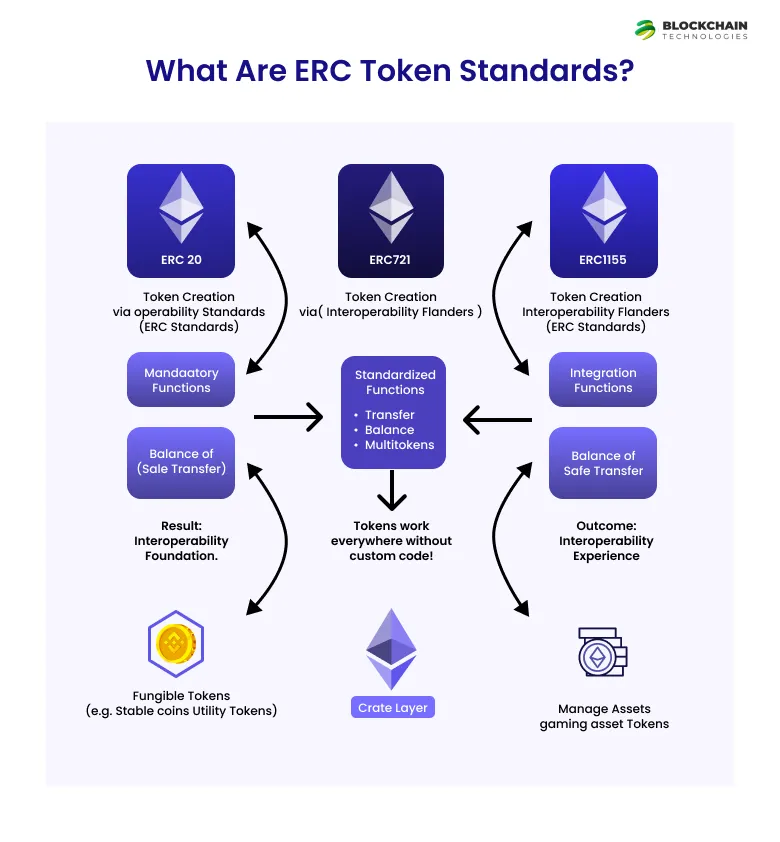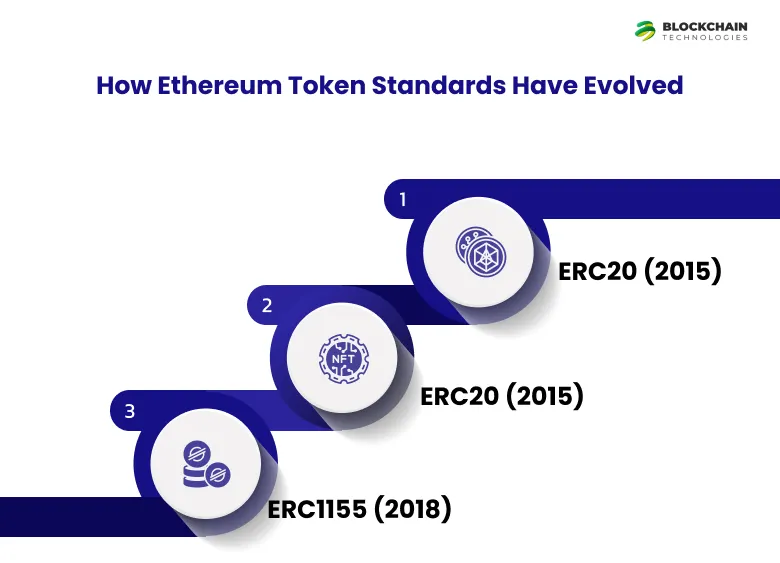ERC20 vs ERC721 vs ERC1155: A Complete Guide to Ethereum Token Standards
Nov 28,2025
ERC20 vs ERC721 vs ERC1155: A Complete Guide to Ethereum Token Standards
Ethereum’s token economy relies on standardized interfaces prescribed by Ethereum Improvement Proposals (EIPs). Many developers often search for comparisons like ERC-20 vs ERC-721 vs ERC-1155 explained simply because each standard serves different use cases, from fungible DeFi tokens to unique NFTs and multi-asset gaming inventories.
ERC-20, defined in 2015, fuels more than 500,000 fungible tokens supporting DeFi, stablecoins, and utility tokens on Ethereum. ERC-721, standardized in EIP-721, introduced one-of-a-kind NFTs, while ERC-1155 combines fungible, semi-fungible, and non-fungible tokens in a single contract — making it the preferred choice for gaming, bulk NFT drops, and metaverse assets.
What Is “ERC” in Ethereum?
Ethereum Request for Comment, or “ERC” is a category of EIPs dedicated to the standards of smart contracts. Every ERC is a design document that defines function signatures, events, and behaviors a contract has to implement in order to be deemed compliant. The ERC process promotes community review so that standards are real-world requirements and interoperate harmoniously across the ecosystem.
Every ERC is a design document that defines function signatures, events, and behaviors a contract must implement to be compliant. This is why many developers search for which Ethereum token standard should I use for my project or ERC-20 vs ERC-721 vs ERC-1155 for beginners, because choosing the correct standard affects gas usage, marketplace compatibility, and long-term scalability.
What is Fungible and Non-Fungible Tokens?
Fungible tokens
Fungible tokens are said to be digital assets that can be interchangeable against one another and accept the same value within the given one unit relating to another of the same type. On the contrary, the definition of non-fungible tokens includes unique digital assets that are non-interchangeable or one to one basis wherein each token corresponds with a unique set of characteristics, metadata, or ownership history, which makes it a different and irreplaceable token as compared to the others.
Token Standard: The most common standard for fungible tokens is ERC-20 (on Ethereum), which defines how tokens can be transferred, approved, and accessed.
Fungible tokens (ERC-20) work best for currencies, in-game tokens, reward points, and DeFi assets. This is why queries like ERC-20 vs ERC-1155 for gaming or best token standard for utility tokens are common among founders.
Non-Fungible Tokens (NFTs)
Non-fungible tokens represent unique digital assets that are not interchangeable on a one-to-one basis. Each NFT has distinct characteristics, metadata, and ownership history, making it irreplaceable and ideal for digital art, collectibles, gaming items, and property records.
Token Standard: The standard for non-fungible tokens is ERC-721, and for more complex use cases, ERC-1155, which allows for both fungible and non-fungible items in a single contract.
Non-fungible tokens (ERC-721) represent unique digital assets and remain the dominant standard for NFTs. Many creators also ask ERC-721 vs ERC-1155 for NFT collections, because ERC-1155 is cheaper for bulk minting while ERC-721 offers clearer uniqueness and provenance.
What Are ERC Token Standards?

ERC token standards specify a base set of functions and events that smart contracts must support, which allows wallets and dApps to interact with any compliant token predictably. They address:
- Fungible tokens (homogeneous, divisible units)
- Non-fungible tokens (heterogeneous, indivisible assets)
- Multi-token contracts (varied asset types under one contract)
This modularity has pushed Ethereum to become the top programmable money platform.
Ready to launch your Ethereum token?
Launch Your Token in Weeks — Get a free consultation from our blockchain experts today!
How Ethereum Token Standards Have Evolved?

- ERC20 (2015): The initial fungible token standard, allowing interchangeable tokens such as currencies.
- ERC721 (2017): Added NFTs (non-fungible tokens) for one-of-a-kind assets such as digital artwork.
- ERC1155 (2018): A multi-token standard for fungible, non-fungible, and semi-fungible assets in a single contract.
Each version had improved upon the previous one, solving new developers needs—whether fractional ownership, scarcity, or efficient multi-asset transfers.
ERC-20: Fungible Token Standard
ERC-20 defines six required functions (e.g., totalSupply, balanceOf, transfer) and two events (Transfer, Approval) for fungible tokens.
Key Features: Divisibility, interoperability, third-party spending allowance mechanism.
Common Use Cases: Stablecoins (USDT, USDC), governance tokens, DeFi collateral, in-game currencies.
Key Functions:
- transfer(): Transfer tokens to another address.
- balanceOf(): Retrieve an address’s token balance.
Real time Example:
- Chainlink (LINK) utilizes ERC20 for its oracle network payments.
- MakerDAO’s DAI (stablecoin), Uniswap’s UNI (governance).
ERC-721: Standard for Non-Fungible Tokens (NFT)
ERC-721 introduced a structure for unique NFTs using token IDs, ownership tracking, and detailed metadata. It’s ideal for digital art, luxury collectibles, identity verification, and virtual real estate. Many NFT creators still prefer ERC-721 over ERC-1155 for collections where each token must remain distinct, have its own metadata, or maintain strong scarcity traits
Key Features: Uniqueness, metadata by tokenURI, optional enumeration extension for token listing per owner
Key Functions:
- ownerOf(): To check who owns a given token.
- safeTransferFrom(): To transfer NFTs securely.
Use cases: Digital art (CryptoPunks); collectibles (Bored Ape Yacht Club); virtual real estate.
Real time example:
- NBA Top Shot has adopted Erc721 for its highlight collectibles.
- CryptoKitties (collectibles), Decentraland (virtual land)
Need help minting NFTs?
Our ERC721 development experts are here to assist. Accelerate Your Web3 Launch.
ERC-1155: Multiple Token Standard
ERC-1155 is a token that allows a single contract to manage fungible and non-fungible inter-operably using functions such as safeBatchTransferFrom
Key features: Batch operation, gas-efficient (minimally interact with the network for many tokens), flexible token types
Use Cases: In-game items (weapons, skins), tickets, voucher systems
Key Functions:
- balanceOfBatch(): Check multiple token balances.
- safeTransferFrom(): Transfer one or more token types.
Real time Example:
- The Sandbox uses ERC1155 for in-game assets like land and tools.
- Enjin (gaming items), Immutable X (NFT marketplaces).
When to prefer ERC-1155 over ERC721 for NFTs : ERC-1155 is ideal when you need to mint large quantities of similar NFTs efficiently—such as game assets, event tickets, or collectible batches—because it drastically reduces gas costs compared to ERC721
ERC-20 vs. ERC-721 vs. ERC-1155 – A Comparison
- Interchangeability: ERC-20 tokens are interchangeable; ERC-721s are unique; ERC-1155 supports both.
- Gas Efficiency: ERC-1155 saves gas by batching transfers; ERC-20 and ERC-721 require one for each transaction.
- Complexity: ERC-1155 contracts are lengthy and complex, granting greater flexibility.
- Tooling Support: All standards have general tooling support including wallets (MetaMask, Ledger), explorers (Etherscan), and marketplaces (OpenSea).
Interface Comparison of ERC-20, ERC721, ERC-1155

Unsure which standard fits your project?
Talk to our architects for personalized guidance!
Which Token Standard Should You Choose?
Choosing the right Ethereum token standard depends on your project’s goals, asset type, and technical requirements. Here’s a breakdown to simplify your decision:
| Standard | Best For | Key Features | Limitations |
|---|---|---|---|
| ERC20 | Fungible assets | Simple, widely supported. | Cannot handle unique assets. |
| ERC721 | Unique NFTs | Proven NFT standard, strong ecosystem support. | Inefficient for bulk transactions. |
| ERC1155 | Hybrid or multi-token use | Batch transfers, gas efficiency, flexibility. | Less adoption than ERC20/ERC721. |
When to Use Each Standard
1. Choose ERC20 If…
If you are creating a currency, reward points, or utility tokens. If the project relies heavily on mass adoption (for example, DeFi integration). For example: A DEX will require a governance token, such as UNI.
2. Choose ERC721 If…
If your assets are unique (for example, art, music, virtual land). Both scarcity and provenance matter (for example, Bored Ape NFTs). For example, an NFT collection with limited editions launched by a digital artist.
3. Choose ERC1155 If…
You require fungible and non-fungible tokens (for example, a game with gold coins and unique skins). Batch operations are important (for example, sending out one-time event tickets for 1,000 users all at once). For example, A game built on a blockchain like The Sandbox will manage land, tools, and currency.
Our Comprehensive Ethereum Development Services
We support full-cycle Ethereum token development—including ERC-20 creation, ERC-721 NFT development, and ERC-1155 multi-token smart contracts—optimized for scalability, gas efficiency, and marketplace compatibility. Our developers build secure, audit-ready smart contracts tailored for Web3 apps, gaming ecosystems, metaverse projects, enterprise systems, and DeFi platforms.
Below we offer solutions and specialties that cover end-to-end Ethereum solutions, from conducting smart contract audits and implementing the appropriate token standards to full-stack development of dApps and integration into various marketplace platforms. Be it ERC-20 launches, NFT platforms, or whole multi-token gaming ecosystems, you can be assured of security, scalability, and seamless end-user experience by our experienced developers.
Development of Smart Contracts
- Smart contract Development:
Establishment and implementation of decentralized smart contracts for the purposes of automation and security. Know More Our Smart Contract Development Services
- ERC Token Development:
Custom ERC-20, ERC-721, and ERC-1155 token creation tailored to any of a number of different application use cases such as NFTs, utilities, and others.
- DeFi Solution:
Decentralized finance protocols and applications become lending, staking, liquidity pools, and DeFi yield farming platforms.
- DApp Development:
Development of decentrally controlled applications (DApps) on Ethereum-managed transparent operations. Read more of DApp Development
- Ethereum based NFT Development:
NFT marketplace solutions with NFT minting and integration on the Ethereum network.
- Integration of Ethereum Blockchain:
Integration of Ethereum blockchain with existing applications and platforms for better decentralization and security.
- Ethereum Scaling Solutions:
The use of Layer-2 scaling techniques including Optimistic Rollups, zk-Rollups way, and sidechains to boost throughput in transacting on the Ethereum network.
- Ethereum Wallet Development:
Personalized Ethereum wallets for securely and properly accessing digital assets and tokens.
- Security Audit & Vulnerability Testing:
Complete auditing of smart contracts, vulnerability testing, and securing code from hacks and exploits. Get Smart Contract Audit Services
- ICOs/IEOs on Ethereum:
Initiate Initial Coin Offering or Initial Exchange Offering for fund raising and distribution of tokens.
- Blockchain Consultancy:
Blockchain consultancy involves consulting expertise on Ethereum projects, best practices, and opportunities for blockchain integration.
- Ethereum Migration Services:
Migration of existing applications to the Ethereum blockchain to gain benefits in decentralization, transparency, and security.
Conclusion
Understanding ERC-20, ERC-721, and ERC-1155 standard is vital for making a decision on the right token standard and architecting secure, efficient Ethereum applications. From fungible tokens powering DeFi to NFTs revolutionizing digital ownership and multi-token contracts facilitating batch transactions, each of these standards serves its specific niche in the blockchain ecosystem. Take your blockchain project to the next level — contact BlockchainTechs.io today for a free project consultation!
FAQs
Ethereum token s, standards similar as ERC20, ERC721, and ERC1155, define a set of rules and protocols for creating commemorative the Ethereum blockchain. These norms insure interoperability between different decentralized operations( dApps), holdalls , and exchanges. By using these established rules, inventors can produce commemorative that are widely compatible across the Ethereum network.
ERC20 Used for commutable commemorative like cryptocurrencies and stablecoins.
ERC721 Used for NFTs, where each commemorative is unique and can not be replaced by another.
ERC1155 A for versatile standard supporting both commutable and non-fungible commemoratives, making it ideal for game means and NFTs in batches.
Each token standard would have a prescribed list of required functions. Examples include:
- ERC20: transfer(), balanceOf(), and approve() respectively.
- ERC721: ownerOf(), safeTransferFrom(), and setApprovalForAll().
- ERC1155: balanceOfBatch(), safeTransferFrom(), and setApprovalForAll().
They enable transfer of tokens, balance keeping, and users’ interaction with tokens on their platform.
Yes, all three types of tokens are highly compatible with decentralized apps (dApps) in the case of the Ethereum internetwork. ERC20 is mostly utilized in DeFi protocols, ERC721 finds its application in most NFT marketplaces, while ERC1155 tokens are being developed and used in gaming and digital collectibles dApps.
The tokens made from the ERC20, ERC721, and ERC1155 standards can be directly managed through wallets like MetaMask. Each type of token can be stored, transferred and displayed through compatible wallets, creating a seamless experience for users to manage their assets.
- ERC20: USDT (Tether), Uniswap (UNI) and Chainlink (LINK) are examples of ERC20 tokens highly traded within the cryptocurrency market.
- ERC721: Examples of ERC721 NFTs within the art and gaming sectors would include Cryptokitties, Bored Ape Yacht Club (BAYC), and Decentraland land plots.
- ERC1155: Enjin Coin, Gods Unchained (game assets) and Axie Infinity (in-game assets) are all examples of assets using the ERC1155 standard for their multi-token ecosystem.
It would be impossible to arrive at a standard value of token development because other factors like the complexity of a token, smart contract requirements, gas fees for deployment, and the time taken for testing considerably affect the price of token development. On average, creating an ERC20 token is less costly than creating an ERC721 or ERC1155 token since ERC20 tokens can be developed quite simply. According to estimates, $2,000 to $5,000 would be charged for typical ERC20 tokens, while ERC721 and ERC1155 could cost above $5,000 due to extra complications in handling unique or multi-token assets.
If you are looking for a more customized development solution along with these tokens integrated with decentralized apps, the price would vary as per the size of the project and requirements.

